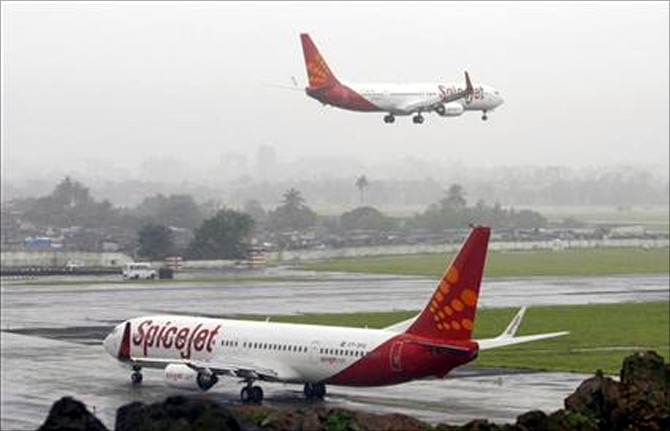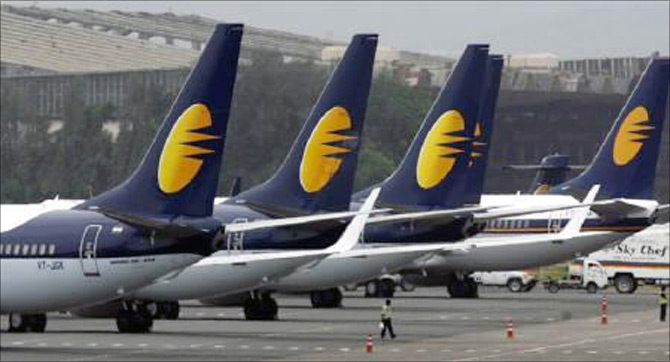
Recent attempts to salvage the situation might not be enough thanks to the rise in jet fuel prices and depreciation of the rupee.
For a moment, it seemed as if the aviation business was about to turn the corner: losses would be wiped out, and the sector would live happily ever after.
Passenger traffic grew almost 14 per cent in the quarter ended September 30 as compared to the year-ago quarter.
Two low-cost carriers, IndiGo and GoAir, reported strong numbers.
GoAir reported its maiden profit of Rs 104.34 crore (Rs 1.04 billion) in 2012-13 as against a loss of Rs 133.72 crore (Rs 1.33 billion) in the previous year. The company clarified that the profit was due to the changes in accounting policies with respect to aircraft lease rentals (or else, it would have made a loss of Rs 79.28 crore), yet the euphoria was unmistakable.
IndiGo announced that its (gross) profit had risen to Rs 993 crore (Rs 9.93 billion) in 2012-13, compared to Rs 64 crore (Rs 640 million) in the previous financial year.
Even debt-laden state-owned Air India was said to be on the path to recovery, having slashed its workforce, inducted fuel-efficient Dreamliners into its fleet and embarked on its ambitious asset-monetisation drive.
The party was spoiled somewhat when Jet Airways announced a staggering consolidated loss of Rs 998 crore (Rs 9.98 billion) for the quarter ended September 30. It was its third straight quarter in the red.
...

The loss was six times higher than Rs 165 crore (Rs 1.65 billion) in the corresponding period last year and 28 per cent more than Rs 778 crore (Rs 7.78 billion) in the whole of 2012-13. Then SpiceJet announced a loss of Rs 559 crore (Rs 5.59 billion) in the September-ended quarter, three-and-a-half times the loss in the same quarter of 2012-13.
According to the Centre for Asia-Pacific Aviation, or CAPA, which analyses the aviation market in the region, all Indian carriers put together, including IndiGo, lost over $500 million in the September-ended quarter.
Too little, too late
The airlines, for their part, are trying to bounce back after a disappointing quarter. Towards the end of September, all of them upped fares by 15 to 25 per cent. But, privately, they acknowledge that this may be too little, too late.
All this has done is to bring their fares in line with last year's - it does not take care of the rise in input costs during the period. Meanwhile, thanks to the fare increase, the passenger load factor came down in October from September.
Most airlines fear it will be a dreary winter in the next two months. To put it in different words, the current quarter may not see any dramatic turnaround in the fortunes of the sector.
...

What went wrong? Who is responsible for this mess? Full-service carriers between July and August followed a suicidal strategy to woo customers. They brought fares down sharply to almost the levels of the low-cost carriers, even though their cost of operations is substantially higher. And they did so when the depreciation of the rupee and higher fuel costs had put immense pressure on their costs.
Instead of raising fares to deal with the situation, they dropped fares, which pushed the industry into losses. For example, the average fare on the Delhi-Mumbai sector was Rs 5,800 to Rs 6,000 in August this year, nearly 30 per lower than last year in the same month.
This happened because Jet Airways offered over 700,000 seats, starting from Rs 1,777, across sectors to customers as a promotional offer. The idea was to gain traffic and increase the topline; with constant costs, that would have helped the bottom-line as well.
But that assumption didn't hold. The low-cost carriers had no choice but to match or undercut the new fares to stay afloat. Everybody bled, in the process.
...

In the first quarter of this year (April to June), the full-service carriers sold their tickets, on an average, for Rs 5,200 to Rs 5,600. The low-cost carriers sold tickets, on an average, at around Rs 4,200. The difference was below 30 per cent and was manageable- it wasn't small enough to trigger a shift from low-cost to full-service carriers.
In the second quarter, the equilibrium went haywire. The full-service carriers dropped fares dramatically to Rs 4,000 to Rs 4,500, forcing the low-cost carriers to cut prices to between Rs 3,600 and Rs 4,000.
"It would not have been possible for us to sell our tickets at a higher price than the full-service carriers; so we had no choice but to bring down fares as much as we could," says a senior executive of a low-cost carrier. As a result, the gap between the two narrowed down to just over 10 per cent. On many days, their fares were the same - there was no difference between full-service and low-cost fares.
...

Harakiri?
The buyer gained, and there was a sharp improvement in the passenger load factor of all airlines, but the business suffered. The full-service carriers slashed fares knowing all too well that their cost of operations are way beyond the low-cost carriers.
According to data compiled by CAPA, the average cost available per seat kilometer of full-service carriers at Rs 6.30 to Rs 6.40 in the September-ended quarter was 50 per cent more than that of the low-cost carriers: Rs 4.20 to Rs 4.30. But the full-service carriers were getting only 10 per cent more from their fares compared to the low-cost carriers.
To make matters worse, the price war was unleashed when the cost of operations was going up for everyone because of the rupee depreciation (payments for jet fuel as well as lease payments, which sometimes constitute over 60 per cent to 70 per cent of total operational costs are made in dollars) and spike in jet fuel prices.
For instance, Jet Airways' fuel costs went up by 34 per cent in the September-ended quarter. (It accounts for over 60 per cent of the airline's total operational costs.) But, instead of passing on the cost increase to passengers, its average gross revenue per passenger fell by 13 per cent.
...

As a result of the drop in fares, it needed passenger load factor of over 102 per cent in order to break even-a statistical impossibility.
The unusual strategy of full-service carriers to take the price war to the low-cost camp is not followed anywhere around the globe. In most countries where both low-cost and full-service carriers operate on the same routes, the price differential is pretty well marked and the products are clearly demarcated.
In Malaysia, for instance, a flight between Kuala Lumpur to Singapore on AirAsia, the low-cost carrier, would be a third of that of Malaysian Airlines, the full-service carrier.
Or Spirit Airways fares between New York and Chicago are over 50 per cent cheaper compared to full-service rivals like American Airlines. And EasyJet fares are 20 per cent cheaper than British Airways between London and Paris.
...

Catch-22 situation
But is the mayhem in the September quarter over and has sense prevailed in the market? Airlines are not sure. They say that the recent fare increase has led to a loss in passenger growth which is reflected in the fall in the passenger load factor in October. So that could be a major impediment for them to raise fares further.
However, if they do not do so, the existing fares are not enough for them to defray the increase in costs over the last one year.
"After the (September) increases, the fares are the same as last year. But costs have gone up 20 to 25 per cent. So who will pay for that," asks a senior executive of an airline company. If that is so, it could be a pretty cold winter for all the airlines.